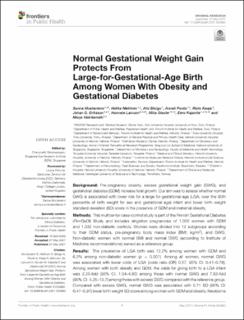| dc.contributor.author | Mustaniemi, Sanna | |
| dc.contributor.author | Nikkinen, Hilkka | |
| dc.contributor.author | Bloigu, Aini | |
| dc.contributor.author | Pouta, Anneli | |
| dc.contributor.author | Kaaja, Risto | |
| dc.contributor.author | Eriksson, Johan G. | |
| dc.contributor.author | Laivuori, Hannele | |
| dc.contributor.author | Gissler, Mika | |
| dc.contributor.author | Kajantie, Eero Olavi | |
| dc.contributor.author | Vääräsmäki, Marja | |
| dc.date.accessioned | 2023-02-06T16:19:13Z | |
| dc.date.available | 2023-02-06T16:19:13Z | |
| dc.date.created | 2021-12-09T15:21:02Z | |
| dc.date.issued | 2021 | |
| dc.identifier.citation | Frontiers in Public Health. 2021, 9 . | en_US |
| dc.identifier.issn | 2296-2565 | |
| dc.identifier.uri | https://hdl.handle.net/11250/3048701 | |
| dc.description.abstract | Background: Pre-pregnancy obesity, excess gestational weight gain (GWG), and gestational diabetes (GDM) increase fetal growth. Our aim was to assess whether normal GWG is associated with lower risk for a large-for-gestational-age (LGA; over the 90th percentile of birth weight for sex and gestational age) infant and lower birth weight standard deviation (SD) score in the presence of GDM and maternal obesity.
Methods: This multicenter case-control study is part of the Finnish Gestational Diabetes (FinnGeDi) Study and includes singleton pregnancies of 1,055 women with GDM and 1,032 non-diabetic controls. Women were divided into 12 subgroups according to their GDM status, pre-pregnancy body mass index (BMI; kg/m2), and GWG. Non-diabetic women with normal BMI and normal GWG (according to Institute of Medicine recommendations) served as a reference group.
Results: The prevalence of LGA birth was 12.2% among women with GDM and 6.2% among non-diabetic women (p < 0.001). Among all women, normal GWG was associated with lower odds of LGA [odds ratio (OR) 0.57, 95% CI: 0.41–0.78]. Among women with both obesity and GDM, the odds for giving birth to a LGA infant was 2.25-fold (95% CI: 1.04–4.85) among those with normal GWG and 7.63-fold (95% CI: 4.25–13.7) among those with excess GWG compared with the reference group. Compared with excess GWG, normal GWG was associated with 0.71 SD (95% CI: 0.47–0.97) lower birth weight SD score among women with GDM and obesity. Newborns of normal weight women with GDM and normal GWG had 0.28 SD (95% CI: 0.05–0.51) lower birth weight SD scores compared with their counterparts with excess GWG. In addition, in the group of normal weight non-diabetic women, normal GWG was associated with 0.46 SD (95% CI: 0.30–0.61) lower birth weight SD scores compared with excess GWG.
Conclusion: GDM, obesity, and excess GWG are associated with higher risk for LGA infants. Interventions aiming at normal GWG have the potential to lower LGA rate and birth weight SD scores even when GDM and obesity are present. | en_US |
| dc.language.iso | eng | en_US |
| dc.publisher | Frontiers Media | en_US |
| dc.rights | Navngivelse 4.0 Internasjonal | * |
| dc.rights.uri | http://creativecommons.org/licenses/by/4.0/deed.no | * |
| dc.title | Normal Gestational Weight Gain Protects From Large-for-Gestational-Age Birth Among Women With Obesity and Gestational Diabetes | en_US |
| dc.title.alternative | Normal Gestational Weight Gain Protects From Large-for-Gestational-Age Birth Among Women With Obesity and Gestational Diabetes | en_US |
| dc.type | Peer reviewed | en_US |
| dc.type | Journal article | en_US |
| dc.description.version | publishedVersion | en_US |
| dc.source.pagenumber | 8 | en_US |
| dc.source.volume | 9 | en_US |
| dc.source.journal | Frontiers in Public Health | en_US |
| dc.identifier.doi | 10.3389/fpubh.2021.550860 | |
| dc.identifier.cristin | 1966749 | |
| cristin.ispublished | true | |
| cristin.fulltext | original | |
| cristin.qualitycode | 1 | |

